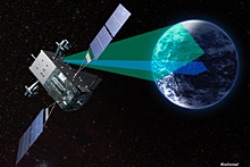The second Space-Based Infrared System (SBIRS) Geosynchronous Earth Orbit (GEO) satellite built by Lockheed Martin to provide our nation continuous early warning of ballistic missile launches and other tactical intelligence was recently declared operational.
 SBIRS GEO Shown here is an artist’s rendering of a SBRIS GEO spacecraft. SBIRS GEO satellites include highly sophisticated scanning and staring sensors that deliver improved infrared sensitivity and a reduction in area revisit times over the current constellation. The scanning sensor provides a wide area surveillance of missile launches and natural phenomena across the earth, while the staring sensor can be tasked to observe smaller areas of interest with superior sensitivity.
SBIRS GEO Shown here is an artist’s rendering of a SBRIS GEO spacecraft. SBIRS GEO satellites include highly sophisticated scanning and staring sensors that deliver improved infrared sensitivity and a reduction in area revisit times over the current constellation. The scanning sensor provides a wide area surveillance of missile launches and natural phenomena across the earth, while the staring sensor can be tasked to observe smaller areas of interest with superior sensitivity.
The SBIRS GEO-2 satellite received Air Force Space Command Operational Acceptance on Nov. 25, just eight months after its March 19 launch from Cape Canaveral Air Force Station, with performance that matches, and in some cases exceeds requirements. SBIRS GEO-1 was declared operational on May 21, 2013.
The SBIRS program delivers timely, reliable and accurate missile warning and infrared surveillance information to the President of the United States, the Secretary of Defense, combatant commanders, the intelligence community and other key decision makers. The system enhances global missile launch detection capability, supports the nation's ballistic missile defense system, expands the country’s technical intelligence gathering capacity and bolsters situational awareness for warfighters on the battlefield.
The SBIRS architecture includes a resilient mix of satellites in GEO, hosted payloads in Highly Elliptical Orbit (HEO) orbit, and ground hardware and software. The integrat¬ed system supports multiple missions simultaneously, while provid¬ing robust performance with global, persistent coverage.
Atlas V SBIRS GEO-2 Launch Highlights
“The certification of GEO-2 just eight months after launch validates the performance advances we expected to start seeing as the SBIRS program moved into full production,” said Jeff Smith, vice president of Lockheed Martin's Overhead Persistent Infrared (OPIR) mission area. “Our team is focused on providing the Air Force with improved affordability and resiliency, as well as evolving SBIRS to new capabilities as we exploit the unprecedented detailed data received from the system.”
Lockheed Martin’s SBIRS contracts include four HEO payloads, four GEO satellites, and ground assets to receive, process, and disseminate the infrared mission data. The company delivered HEO-1 in 2004, HEO 2 in 2005 and HEO 3 this past June. These HEO payloads have provided mission performance surpassing specifications.
This fall, GEO-3 successfully passed functional integration testing of its spacecraft bus and is on schedule for delivery to the Air Force in 2014. GEO-4, also in production, is scheduled for delivery in 2015. Lockheed Martin is currently under contract for SBIRS GEO-5 and GEO-6 long-lead parts procurement.
The SBIRS team is led by the Infrared Space Systems Directorate at the U.S. Air Force Space and Missile Systems Center. Lockheed Martin is the SBIRS prime contractor, Northrop Grumman is the payload integrator. Air Force Space Command operates the SBIRS system.
Headquartered in Bethesda, Md., Lockheed Martin is a global security and aerospace company that employs about 116,000 people worldwide and is principally engaged in the research, design, development, manufacture, integration, and sustainment of advanced technology systems, products, and services. The Corporation’s net sales for 2012 were $47.2 billion